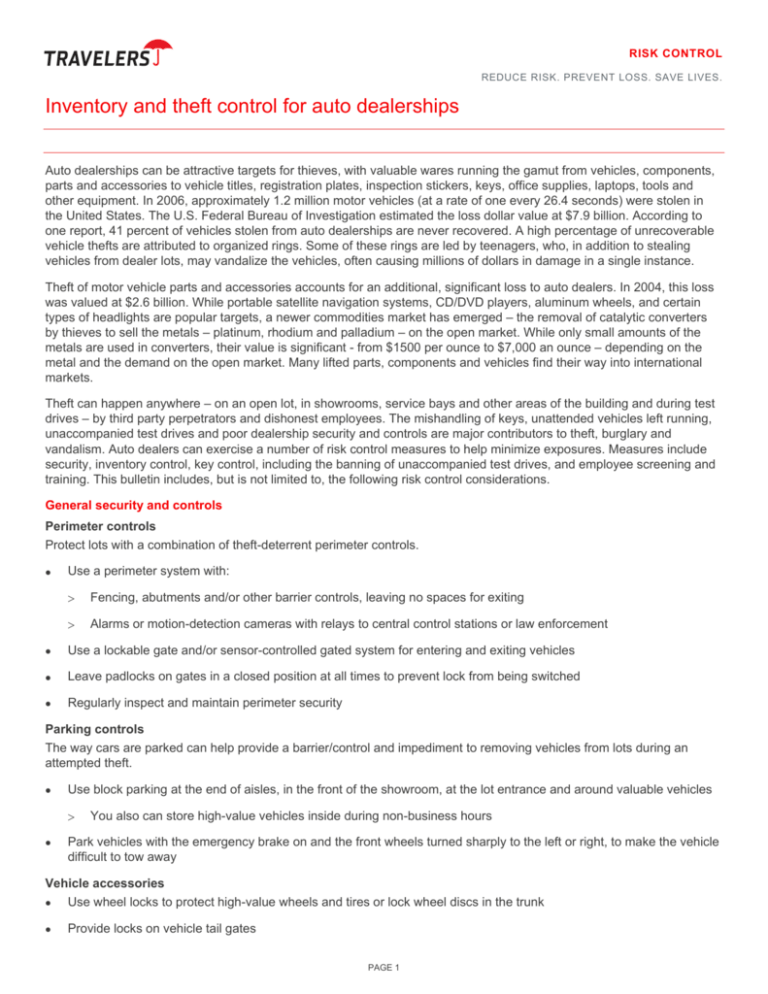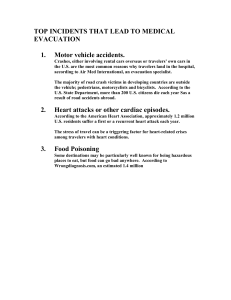
RISK CONTROL
REDUCE RISK. PREVENT LOSS. SAVE LIVES.
Inventory and theft control for auto dealerships
Auto dealerships can be attractive targets for thieves, with valuable wares running the gamut from vehicles, components,
parts and accessories to vehicle titles, registration plates, inspection stickers, keys, office supplies, laptops, tools and
other equipment. In 2006, approximately 1.2 million motor vehicles (at a rate of one every 26.4 seconds) were stolen in
the United States. The U.S. Federal Bureau of Investigation estimated the loss dollar value at $7.9 billion. According to
one report, 41 percent of vehicles stolen from auto dealerships are never recovered. A high percentage of unrecoverable
vehicle thefts are attributed to organized rings. Some of these rings are led by teenagers, who, in addition to stealing
vehicles from dealer lots, may vandalize the vehicles, often causing millions of dollars in damage in a single instance.
Theft of motor vehicle parts and accessories accounts for an additional, significant loss to auto dealers. In 2004, this loss
was valued at $2.6 billion. While portable satellite navigation systems, CD/DVD players, aluminum wheels, and certain
types of headlights are popular targets, a newer commodities market has emerged – the removal of catalytic converters
by thieves to sell the metals – platinum, rhodium and palladium – on the open market. While only small amounts of the
metals are used in converters, their value is significant - from $1500 per ounce to $7,000 an ounce – depending on the
metal and the demand on the open market. Many lifted parts, components and vehicles find their way into international
markets.
Theft can happen anywhere – on an open lot, in showrooms, service bays and other areas of the building and during test
drives – by third party perpetrators and dishonest employees. The mishandling of keys, unattended vehicles left running,
unaccompanied test drives and poor dealership security and controls are major contributors to theft, burglary and
vandalism. Auto dealers can exercise a number of risk control measures to help minimize exposures. Measures include
security, inventory control, key control, including the banning of unaccompanied test drives, and employee screening and
training. This bulletin includes, but is not limited to, the following risk control considerations.
General security and controls
Perimeter controls
Protect lots with a combination of theft-deterrent perimeter controls.
Use a perimeter system with:
Fencing, abutments and/or other barrier controls, leaving no spaces for exiting
Alarms or motion-detection cameras with relays to central control stations or law enforcement
Use a lockable gate and/or sensor-controlled gated system for entering and exiting vehicles
Leave padlocks on gates in a closed position at all times to prevent lock from being switched
Regularly inspect and maintain perimeter security
Parking controls
The way cars are parked can help provide a barrier/control and impediment to removing vehicles from lots during an
attempted theft.
Use block parking at the end of aisles, in the front of the showroom, at the lot entrance and around valuable vehicles
You also can store high-value vehicles inside during non-business hours
Park vehicles with the emergency brake on and the front wheels turned sharply to the left or right, to make the vehicle
difficult to tow away
Vehicle accessories
Use wheel locks to protect high-value wheels and tires or lock wheel discs in the trunk
Provide locks on vehicle tail gates
PAGE 1
RISK CONTROL
Inventory and theft control for auto dealerships
Grounds and building
Keep windows, doors, including loading dock doors, and other openings, such as roof hatches, securely locked during
non-business hours
Avoid placing posters and displays on windows to avoid obstructing the employees' view of outside areas and the
view of local law enforcement making routine rounds
Post “No Trespassing”/security warning signs to deter persons from entering grounds after hours
Post unauthorized entry signs in work areas and offices, including the central key control area
Keep landscaping (trees, shrubs, lawns, fields) well trimmed
Avoid landscaping that hides parked vehicles or makes them less visible
Lighting
Keep the lots and showroom adequately illuminated at all times
Maintain exterior and interior lighting equipment
Lighting systems should meet minimum illumination standards of 3-4 ft. candles
Security cameras, alarm systems and guards
Use closed circuit television cameras and a central alarm system to monitor activities in and around the lot,showroom,
service bays and parts department
The central alarm system vendor should conduct periodic testing
The dealer, central alarm system vendor and law enforcement should construct a response plan
You also can use a remote security service, alerted by motion sensors on the lot, who, in turn, will notify local law
enforcement of possible suspicious behavior
Hire security guards from a reputable service to monitor the premises
Use bonded security guard services
Advise security personnel to be alert to unidentified vehicles and to notify management immediately
If guard dogs are used, post signs alerting to the presence of these dogs. See Risk Control’s technical bulletin Use of
Dogs for Security, Crime Prevention and Personnel Assistance
Enable all anti-theft devices and alarms during non-business hours
Routinely check these devices
Post signs alerting of security measures, such as closed circuit television and security guards
Perform regular audits of all security procedures to ensure maintenance programs are up to date, security officers are
patrolling the premises as required, and reports are being filed
Staff considerations
Encourage all personnel to be alert to the presence of strangers and report suspicious activity immediately to
management
Train all employees in procedures to follow during and after a theft or robbery
Train employees in the use of holdup alarm systems, mindful of personal safety
Staff should not take any actions that, during a theft or robbery, could jeopardize personal safety
PAGE 2
RISK CONTROL
Inventory and theft control for auto dealerships
Keep side and rear doors locked from outside entry. Do not conflict with the life safety codes requiring easy exiting in
the event of an emergency
Inventory control
Vehicles
Arrange for deliveries (manufacturer, auction and driver exchange) to arrive during normal business hours
Establish a procedure for accepting new inventory
Assign a designated staff person responsible for tracking inventory
Secure the vehicles and record vehicle information into your inventory system/log immediately
Handle the keys immediately in accordance with your key control system
Conduct vehicle inventory routinely
Count vehicle inventory at the end of each day and document
Have a theft report procedure
All employees should know to whom to report theft
A point person should report theft immediately to police and your claim administrator
Use a dealer tag accountability control system
Parts, accessories and equipment
Have a documented inventory control process for parts, accessories and equipment
Conduct an inventory check against the log routinely
Keep a record of serial numbers/identification markings on high-value equipment, so they can be traced
Keep vehicle parts and accessories in a secure location or location with limited access to authorized personnel
Secure high-value merchandise in a burglary-resistant safe or other security enclosure, during non-business hours
Cash accounting
Keep cash to a minimum. Interviews with robbers have indicated that when the amount of available cash is small, the
robbery attractiveness drops
Post signs noting availability of limited cash
Restrict employee access to cash
Deposit large bills and amounts of cash in burglary-resistant safes, until deposited daily at the bank
Transfer all deposits – cash and checks – to the bank daily on a random schedule
Have an accounting control system for bank deposits and withdrawals, issuance of checks, payrolls, reconciliation of
bank statements, and the paying of invoices. This should be routinely audited to ensure against embezzlement
Key control
Have a diligent key control system. All keys should fall under the dealer’s key control program
Assign a key custodian with accountability for the system
PAGE 3
RISK CONTROL
Inventory and theft control for auto dealerships
If a key is missing, secure the vehicle immediately
If the vehicle is missing, report to police and your claim administrator immediately
Follow your key control procedure for replacing missing demo keys
See Risk Control’s technical bulletin Key Control Procedures for Auto Dealerships
Lock all vehicles when not in use
This includes lot inventory, customer vehicles in service bays and repair areas of outside lots and industrial
equipment, such as forklifts
If lock boxes are used, remove keys from the lock boxes before closing each day and leave the boxes open to deter
potential thieves from vandalizing the boxes
Never relinquish a demo key to a third-party unless accompanying the driver
The salesperson should be in the vehicle before relinquishing a key for test drives and driver switches
See Risk Control’s technical bulletin Test Drive Procedures for Auto Dealerships
Employee dishonesty
Cash, materials and supplies, tools, equipment and stock (vehicles, parts and accessories) can be subject to theft and
embezzlement by dishonest employees. As with other retail industries, there also can be exposure to credit card and
check fraud. Auto dealers should have a formal employee screening and hiring program that includes background checks.
Screen all job applicants before offering employment
Bond employees with financial responsibilities
See Risk Control’s Employment Practices Liability Exposure Management Guide
For more information, log in to the Risk Control Customer Portal at travelers.com/riskcontrol. (Need help? Read
our Registration Quick Guide.) You also can contact your Risk Control consultant or email Ask-RiskControl@travelers.com.
travelers.com
The Travelers Indemnity Company and its property casualty affiliates. One Tower Square, Hartford, CT 06183
The information provided in this document is intended for use as a guideline and is not intended as, nor does it constitute, legal or professional advice. Travelers does not
warrant that adherence to, or compliance with, any recommendations, best practices, checklists, or guidelines will result in a particular outcome. In no event will Travelers or
any of its subsidiaries or affiliates be liable in tort or in contract to anyone who has access to or uses this information. Travelers does not warrant that the information in this
document constitutes a complete and finite list of each and every item or procedure related to the topics or issues referenced herein. Furthermore, federal, state or local
laws, regulations, standards or codes may change from time to time and the reader should always refer to the most current requirements. This material does not amend, or
otherwise affect, the provisions or coverages of any insurance policy or bond issued by Travelers, nor is it a representation that coverage does or does not exist for any
particular claim or loss under any such policy or bond. Coverage depends on the facts and circumstances involved in the claim or loss, all applicable policy or bond
provisions, and any applicable law.
© 2008-2013 The Travelers Indemnity Company. All rights reserved. Travelers and the Travelers Umbrella logo are registered trademarks of The Travelers Indemnity
Company in the U.S. and other countries. A0169
PAGE 4







